The Pitching
Mechanic
July 2006
Real-Time Illustrations and Analyses of
Proper and
Improper Pitching Mechanics
The Pitching Mechanic - August 2006
7/31/2006
Adam Ottavino: Nice Choice
I think my Cardinals made a good
choice in drafting Adam Ottavino (assuming he ends up playing for
them).
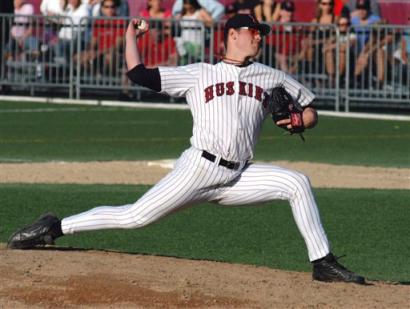
The photo above
shows several things that I like.
First, I like that his hips are rotating well ahead of
his shoulders. That means that he throws with his body and not
just with his arm, which should improve his longevity.
Second, his timing seems to be good; his forearm
appears to be vertical at the moment that his shoulders start to
turn. This should help to reduce the strain on his shoulders.
Third, I
like that his knee is bent in the photo above. While this will
lower his release point (which can be problematic), I believe that
it should also reduce the stress on his arm by allowing his body
to absorb some of the shock of throwing the ball.
Fourth, I like
how his palm is facing Third Base or even Home Plate. I believe
that this will reduce the strain on his UCL and should reduce the
likelihood that he will need Tommy John surgery at some point.
7/18/2006
Good Old Freddy Garcia
I love Freddy Garcia's pitching mechanics.
Yes, they are unusual. However, I believe they will help him have
a long, injury-free career.
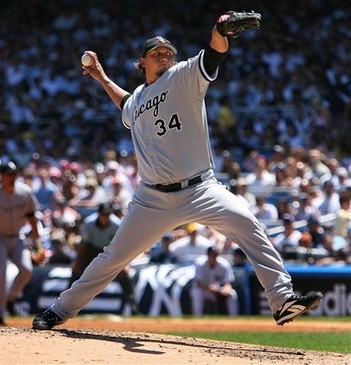
The thing to notice
about Freddy Garcia in this picture is how early he gets his
pitching arm up. Notice that Freddy Garcia's arm is pretty much up
and in the high cocked position while his glove-side foot is still
at least 6 inches off the ground.
This is an example of what Dr. Mike Marshall means when
he talks about how pitchers should use the crow hop throwing
motion. Getting the arm up this early will protect his shoulder by making it
virtually impossible for him to have a problem with
rushing
(and rushing is a flaw that I believe cause both control problems
and shoulder problems).
7/18/2006
What Striding Sideways Looks
Like
I often talk about how pitchers
should stride sideways to the target. This keeps the hips closed
as long as possible and enables them to powerfully pull the
shoulders around.
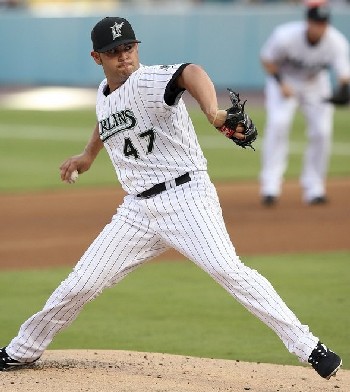
The picture above of
Ricky Nolasco is a good example of what this looks like. Notice
how he's leading with the side of his glove-side foot and how his
glove-side hip is ahead of of his glove-side shoulder.
I also like how his glove-side knee is bent slightly.
This will keep him from landing too hard on his glove-side foot.
7/17/2006
How Kerry Wood (Actually)
Throws The Ball
In the interest of educating
people about what pitchers' arms actually do as they throw the
ball, I have put together this
image sequence that shows Kerry Wood throwing a pitch. The
idea is to give people a common reference point to talk about with
respect to pitching mechanics. Right now, it's uncommented, but at
some point I will go back and add my comments about what's going
on at certain critical moments.
Ideally, this will silence the people who say that my
analyses are fatally flawed because they are based solely on the
analysis of separate still images. I also hope it points out the
problems with analyzing just videos; namely low resolutions and
frame rates.
7/7/2006
How Chris Carpenter (Actually)
Throws The Ball
As I have said elsewhere, one
common piece of advice that I think is potentially dangerous
advice is that pitchers should show the ball to second base as
they pass through the high cocked position.
This advice is based on a very common
misconception; that when throwing a baseball a player comes to the
high cocked position and, as they rotate their shoulders, their
pitching arm stays in the high cocked position (e.g. upper
arm horizontal at the level of the shoulders and forearm vertical)
as is shown in the picture below...
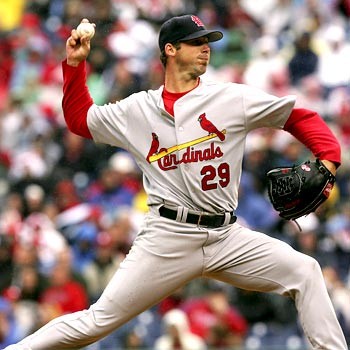
If this was the case, then
showing the ball to 2B would make sense since at the end of the
rotation of the shoulders you would be showing the ball to home
plate.
But it's not the case, and that is why Chris Carpenter
is not showing the ball to Second Base in the
photo above.
What really happens is that, as the shoulders start to
turn, the pitching arm side upper arm externally rotates so that
forearm bounces or lays back to a horizontal position. You can see
this process starting in the photos below of Chris Carpenter...
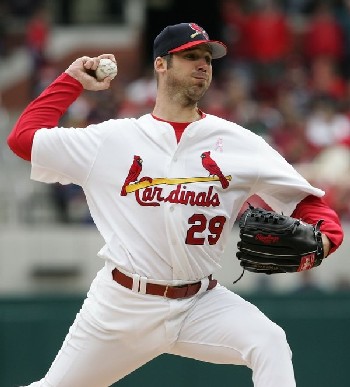
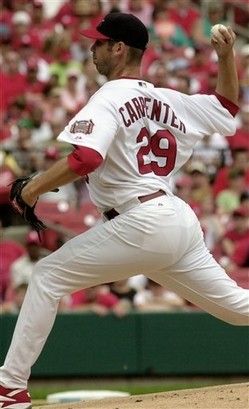
...and you can see full external
rotation in the photo below...
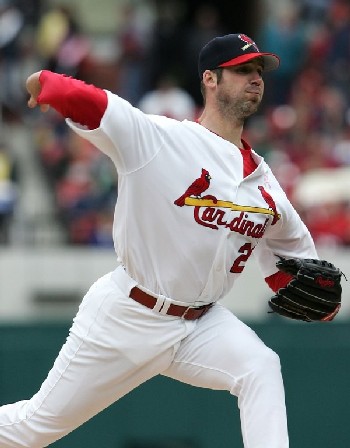
As the shoulders stop turning,
the elbow rapidly extends (or flies out) the 90 degrees that it is
bent...
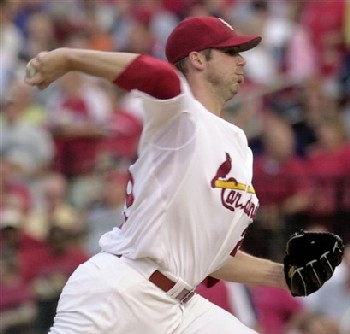
...and ends up like this...
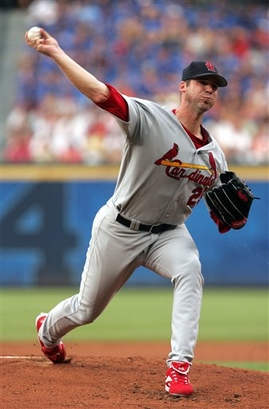
I prefer that pitchers show the
ball to third base, as Chris Carpenter is doing in the first photo
above.
If
you want to see a more in-depth examination of what happens to the
arm as a pitcher throws the ball, go to my web site and read my
document...
-
How Roger Clemens (Actually) Throws The Ball
You can also see this process happen in most of the
professional pitcher analyses that I have posted to my web
site.
7/7/2006
Mike Mussina's Knuckle Curve
Grip
For a variety of reasons, I do
not believe that pitchers younger than the age of 16 or 17 should
throw curveballs. However, I know that a curveball can be an
effective pitch. A good compromise is the knuckle curve, and Mike
Mussina has one of the best knuckle curves in the major leagues.
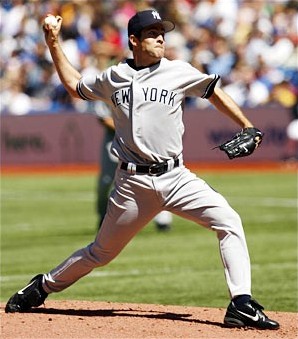
The above picture isn't the
greatest, but it shows the basics of Mussina's knuckle curve grip.
The basic idea is to grip the ball something like a fastball, but
with the index finger curled up with its tips digging into the
seam at the top of a horseshoe. By gripping the ball this way,
when the ball is released the index finger extends and gives the
ball a slight topspin, which causes it to move unpredictably as it
approaches the plate.
7/7/2006
Tim Wakefield's Knuckleball
Grip
I know that some people think
that only wimps throw knuckleballs, but I love any pitch -- or
pitcher -- that's effective. As a result, below is a picture of
Tim Wakefield gripping his Knuckleball.
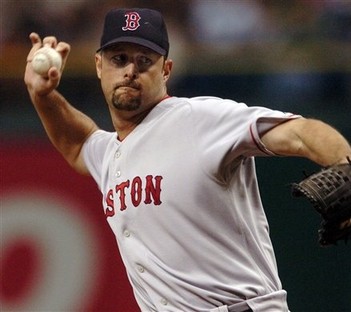
There are a couple
of things to notice in this picture.
First, he's only holding the ball with four fingers;
the ball is held between his ring finger and his thumb (and both
of these fingers are on a seam) and his pinkie is sticking up in
the air. Second, he has the tips of his index and middle fingers
dug into the seam.
I tried this grip out myself and it did allow me to
throw the ball with very little spin.
7/6/2006
My Opinion of Jon Lester
If you've ready any of my stuff,
you know that I am a big fan of pitchers whose hips rotate well
ahead of their shoulders. I believe that this enables them to
generate lots of power using the large muscles of their body; to
throw with their body more than their arm.
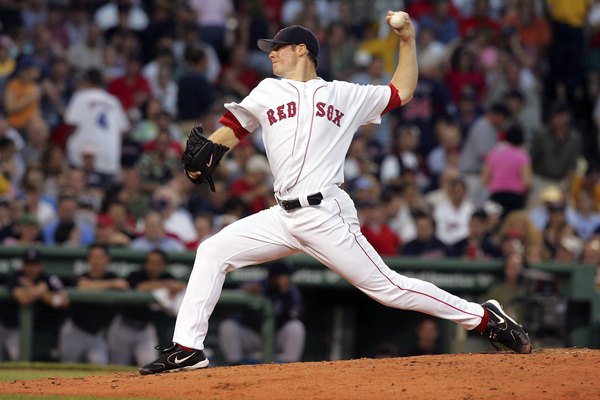
This
photo of Jon Lester is a great example of what this
looks like in action. Notice how his belt buckle is
facing the plate while his shoulders are facing 1B
(and how the buttons on the front of his jersey
curve sharply down and to the left) in both the
photo above and the one below.
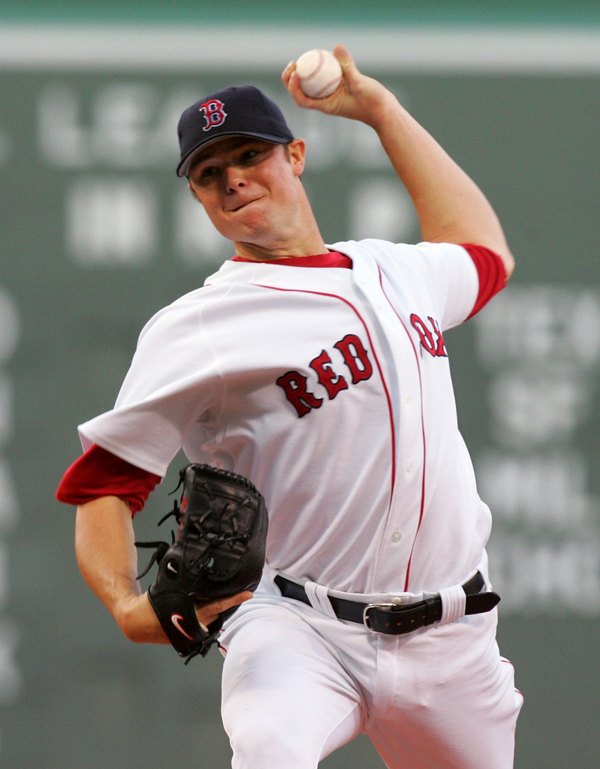
However, my opinion of Jon Lester isn't uniformly
positive. In the photo below, you can see that he
brings his elbows both above and slightly behind his
shoulders.
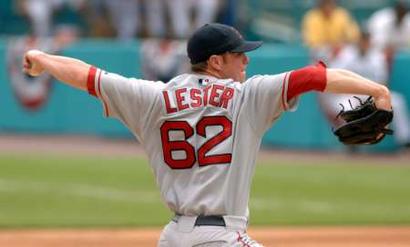
While
he doesn't do this as much as Anthony Reyes and Mark
Prior do, I believe it is a cause for concern about
the long-term health of his shoulder.
7/6/2006
What I Like About Kip Wells
So that I don't start this blog
out on a totally down note, let me balance out my low opinion of
the mechanics of Anthony Reyes with a good evaluation of the
mechanics of Kip Wells. The photo below is an example of very good
timing.
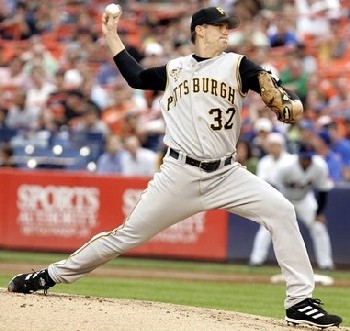
Notice that Wells' glove-side
foot is just about to plant on the ground and his pitching-arm-side
forearm is vertical and in the Ready position. You can also see, by looking at the
line of buttons down the front of his jersey, that at this moment
Wells' hips are rotating well ahead of his shoulders. Wells is
also landing pretty much flat on his glove-side foot.
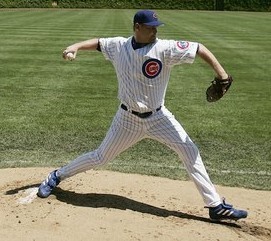
Contrast Kip Wells' timing with
that of Kerry Wood in the picture above. At basically the same
moment, Wood's pitching arm side forearm is in a much lower position
(below horizontal). This means that
Wood is most likely rushing his delivery to the plate, which will cause both
control problems (balls up in the zone) and will increase the
level of stress on his shoulder. You can also see that in the
photo above that Kerry Wood lands more on his heel, which can
cause control problems.
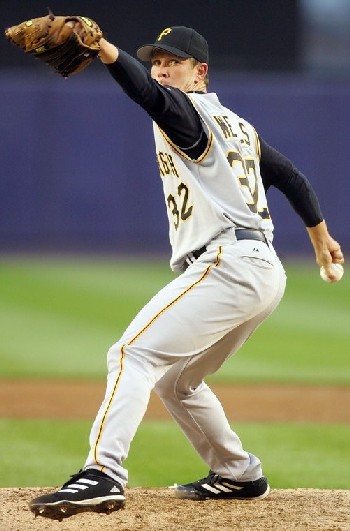
The photo above also
makes it clear that Kip Wells does a good job of keeping his front
hip closed as he strides toward the plate. Notice how he his
striding toward the plate with the side of his glove-side foot,
and not his toe.
7/5/2006
My Concerns About Anthony
Reyes
Let me get this blog started by
talking about the mechanics of Anthony Reyes and making a
prediction about his future prospects.
I know that a lot of people are extremely high on
Anthony Reyes. However, I believe that I see a flaw in his
mechanics that may very well make him the Cardinals' Mark Prior
(and that's not a good thing). By that I mean a pitcher who shows
tons of promise but ends up with continual injury problems.
The problem that I have with Reyes' mechanics is that,
as you can see in the photos below, he takes his elbows both above
and behind his shoulders, which I call
Hyperabduction.
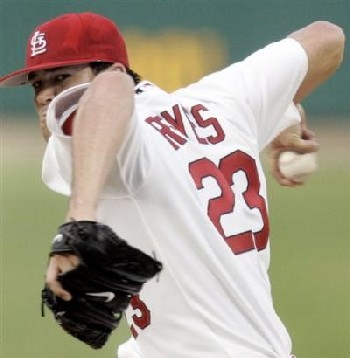
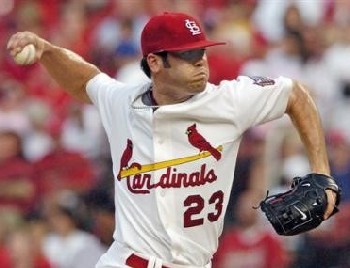
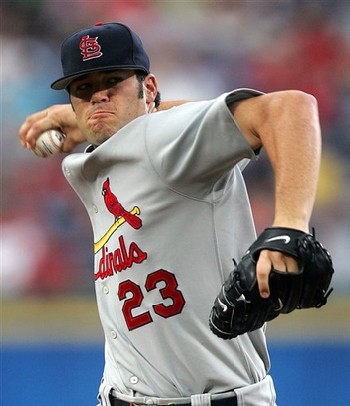
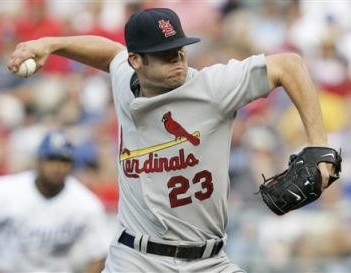
While some people
call this making an "Upside Down W", and think it's a good thing,
I think it is a bad thing because it excessively stresses the
muscles of the rotator cuff.

As the photo above
shows, Mark Prior of the Cubs also
Hyperabducts his PAS upper arm. I
believe that this is related to Prior's recent shoulder problems.
7/5/2006
Getting Started
I have begun to develop a
decent-sized following of people from around the world who are
interested in my ideas about baseball, pitching, and pitching
mechanics. As a result, I am starting this blog to share with
people what I am currently thinking.
One thing that I plan to do in this blog is to do more
real-time illustration and analyses of the pitching mechanics of
major-league
pitchers. Of course, I still plan to continue putting together my
detailed analyses of the pitching mechanics of pitchers,
but those analyses take a lot of time. I hope that this will be a
way that I can share my knowledge with people in a way that
addresses both your needs and mine.
Please feel free to
contact me if you have any questions
for me or suggestions for topics that I should address in this
blog.
|